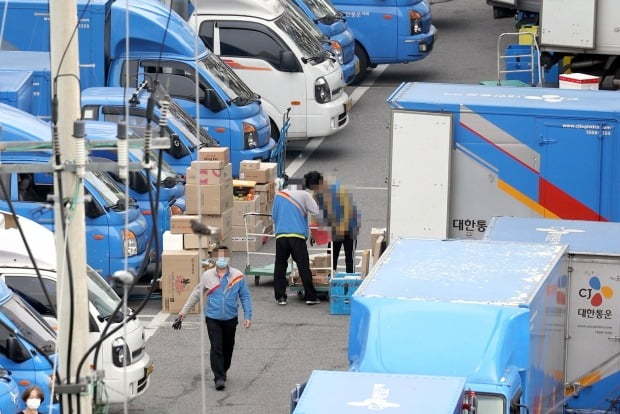 |
Delivery workers at a logistics center move parcels. (Yonhap) |
South Korea’s economically active population used courier services once every four days on average last year, spending an average of 2,221 won ($2) per order, new government data revealed.
The volume of parcels reached 3.37 billion, a 20.9 percent year-on-year increase, the National Logistics Information Center said on Sunday, citing data from the Korea Integrated Logistics Association.
The country’s economically active population -- those aged 15 and over either in employment or seeking employment -- used a courier service 112 times per year on average, up 22.7 times.
Among all age groups, people used a courier service an average of 65.1 times, up from 53.8 one year ago.
Within the economically active population alone, the number has jumped 24.4 times compared to the year 2000 when people on average used a courier service five times a year.
The courier service market in the country racked up 7.49 trillion won in sales last year, up 18.4 percent from the previous year amid a rise in online shopping as a result of the coronavirus pandemic.
Against this backdrop, local major e-commerce giants such as Coupang and Naver’s online shopping unit posted notable growth in 2020.
Coupang’s total net revenues were $12.0 billion, up 90.8 percent from 2019, according to its IPO report filed to the US Securities and Exchange Commission.
Naver’s commerce unit racked up 1.09 trillion won in revenue last year, up 37.6 percent.
In a further sign of the growing industry, the Ministry of Justice last week announced plans to revise the immigration law to allow logistics companies to employ foreign nationals to tackle the growing shortage of workers in the field.
Last year, online shopping transactions amounted to a total of 161.1 trillion won, up 19.1 percent, according to data from Statistics Korea.
The average delivery cost per parcel stood at 2,221 won, down 48 won or 2.1 percent from one year ago.
According to the National Logistics Information Center, the average delivery cost has been in decline at the rate of 0.8 to 3.1 percent since 2012 when the price stood at 2,506 won, before reaching 2,229 won in 2018.
In 2019, the price bucked the trend and jumped to 2,269 but eased again the following year.
By Yim Hyun-su (
hyunsu@heraldcorp.com)








![[Today’s K-pop] Blackpink’s Jennie, Lisa invited to Coachella as solo acts](http://res.heraldm.com/phpwas/restmb_idxmake.php?idx=644&simg=/content/image/2024/11/21/20241121050099_0.jpg)